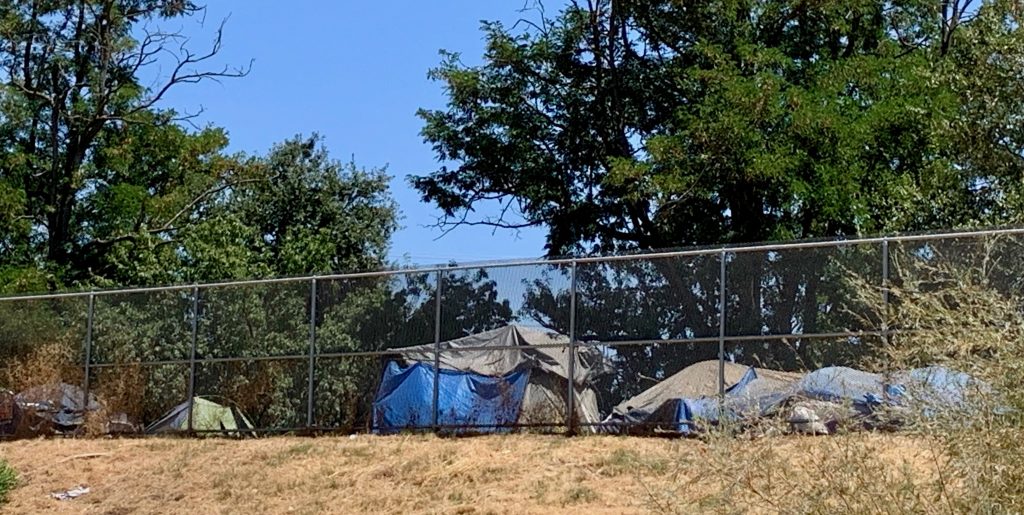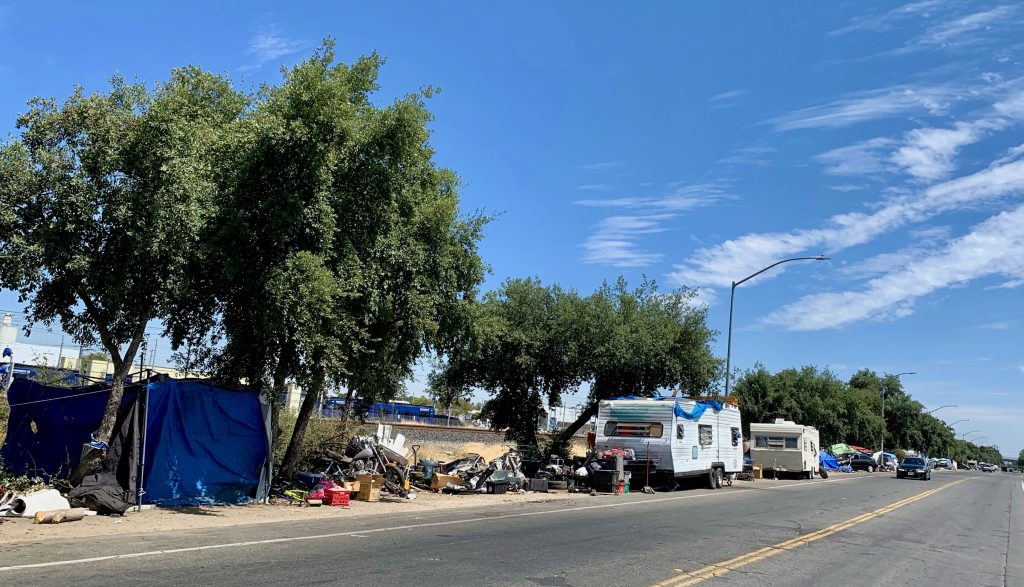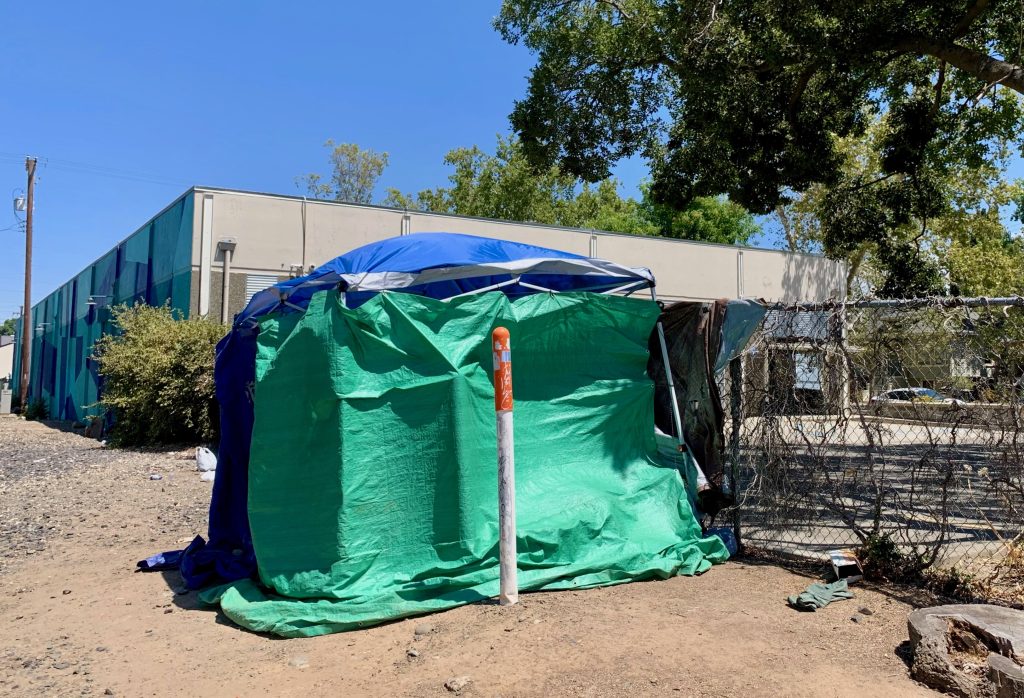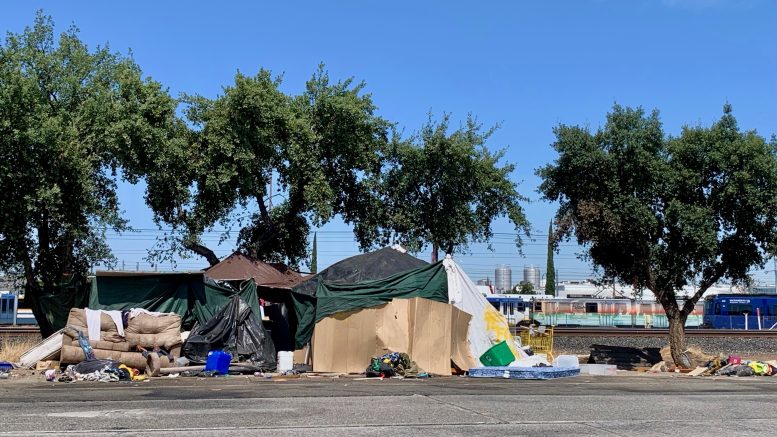Local jurisdictions claim increased but measured enforcement, Camp Resolution goes to court to prevent its demise
By Scott Thomas Anderson
“No more excuses,” Gov. Gavin Newsom posted on X (formally Twitter) on July 25. “We’ve provided the time. We’ve provided the funds. Now it’s time for the locals to do their job.” Newsom wrote these lines above an Associated Press story he was reposting, one that announced he’d “issued an executive order for the removal of homeless encampments in the state.”
The governor’s order hit many Californians as the news equivalent of a thunderbolt, with some property owners believing they’d never deal with an encampment again and advocates for the unhoused fearing that a mass-mobilization of law enforcement would displace tens of thousands of vulnerable people and forcefully scatter them to the winds.
A few weeks later, neither of those scenarios has come to pass. Despite the language in Newsom’s post appearing to call out — and command — local governments, the fine print of his mandate shows that it only applies to state agencies working for him.
And the two state agencies on the frontline of illegal camping in the Sacramento region are now refusing to answer questions or grant interviews regarding how, or if, they will carry out Newsom’s executive order.
The ruling and the order

The public confusion has its origin in a U.S. Supreme Court ruling, City of Grants Pass v. Johnson, that came down in mid-June.
In a 6-3 decision, the justices determined that local governments do have the legal authority to clear encampments through issuing citations and making arrests, even if there is no shelter space for unhoused people to go to once they’re ejected. The decision reversed an earlier ruling called Martin v. Boise by the U.S. Court of Appeals for the Ninth Circuit, which found that cities and counties that engaged in such camp-clearing were participating in cruel and unusual punishment.
Martin v. Boise caused state and local governments to spend the last five years understanding that they couldn’t involve their court systems when dealing with complaints, environmental impacts and fire hazards associated with illegal encampments — unless they first had serious shelter capacity.
While the Supreme Court tossed that concern out the window, the justices’ written decision never implied that governments must, or even should, engage in widespread camp-clearing.
When Newsom posted about his executive order, on the other hand, it read to many as a clear mandate for local jurisdictions to start sweeping camps. After all, he’d specifically written “Now it’s time for the locals to do their jobs.”
Given that most city and county governments complied with all of Newsom’s executive orders during the pandemic, public fears or expectations about what would follow this new encampment order were high.
But the July 25 post was arguably misleading — or, at least, strangely worded.
Newsom’s order only provides strict direction to state agencies working under his administration, and it only applies to encampments on state-owned property. The governor’s full statement reads: “This executive order directs state agencies to move urgently to address dangerous encampments while supporting and assisting the individuals living in them — and provides guidance for cities and counties to do the same. The state has been hard at work to address this crisis on our streets. There are simply no more excuses. It’s time for everyone to do their part.”
Indeed, Sacramento County officials confirmed to Sacramento News & Review that they only interpret Newsom’s order as encouragement to follow his lead, but not as a mandate for their own police actions and code enforcement.
“Sacramento County will continue to use a collaborative, multipronged approach balancing the needs of both the unhoused and the community,” the county’s public information manager Janna Haynes wrote in an email. “We provide compassionate services that address the root causes of homelessness — including outreach, shelter, behavioral health services and rehousing supports … the Grants Pass decision a few weeks back may have impacted decision-making around enforcement and compliance, but not specifically this executive order.”
The City of Sacramento is taking a similar stance.
“I think it is fair to say that the City had been actively working on its analysis of the Grants Pass ruling and appreciated the additional information and guidance provided by Gov. Newsom’s executive order,” noted City of Sacramento Public Information Officer Julie Hall via email. “The City will continue to use all available resources to help address the hardships that people experiencing homelessness face, including offering shelter when available, while also working to protect the health and safety of all City residents.”
Are state properties being cleared?

Folsom Police Chief Rick Hillman has been getting calls from residents wondering why they’re still seeing homeless encampments after Newsom’s executive order. The chief agrees there has been some public confusion following the governor’s post and the proceeding media coverage.
Hillman will also have a front row seat in the coming days as to how much impact the order actually has. That’s because the vast majority of homeless encampments within Folsom city limits stand on land that’s owned by the state of California. Sometimes these camps pop up on parcels managed by the Department of Corrections and Rehabilitation near its prisons. Other times the tents are pitched on state park land along Folsom Lake and the American River. But, according to Hillman, many of the larger encampments have been on land owned by the Department of Fish and Wildlife, or CDFW.
The chief says that, historically, his officers have cleared out encampments in Folsom proper without violating Martin v. Boise by simply contacting the people and convincing them to voluntarily leave (Boise says rights are only violated if officers issue citations or engage in arrests). But Hillman observes that most of those unhoused individuals would just move into much larger, more elaborate encampments on nearby state property. He points out that the land managed by CDFW has had little if any anti-camping enforcement on it since he’s been chief. Hillman is not sure if Newsom’s executive order will change that.
And no one else is sure either because the Department of Fish and Wildlife refuses to say what it will do next.
Contacted in early August by SN&R, CDFW Public Information Officer Steve Gonzalez declined to grant an interview for this story or answer any direct questions about how his agency will be responding to the governor’s directions. Instead, Gonzalez issued a vaguely worded statement saying CDFW “stands ready to support the state’s effort to address homelessness,” and that it will continue to partner with other state and local agencies to address “unhoused encampments with compassion, respect, dignity and a sense of urgency.”
Two hours after CDFW had the exchange with SN&R, California Parks also declined to grant an interview for this story or answer any direct questions about how it would handle Newsom’s order. Public Information Officer Joyeeta Biswas issued a statement that was nearly word-for-word to the one Gonzalez had issued for CDFW that same day, repeating the line of “standing ready to support the state’s efforts to address homelessness” and echoing how it would continue to partner with state and local agencies “while remaining compassionate and respectful of Californians experiencing homelessness.”
SN&R clarified with both Gonzalez and Biswas that they were, in fact, declining to give interviews or answer specific questions. Gonzalez responded that what he’d sent was his department’s “only authorized statement” on the matter, while Biswas and her superior deferred any further communications to the Governor’s Office.
As far as illegal camping goes in Folsom city limits, its council approved funding for a special six-officer homeless outreach team on July 1. So far, that team has cleared out 13 encampments that were generating complaints in the last month, but did so without issuing any citations. Hillman says he’s aware of four unhoused individuals during that time who agreed to be helped into shelters thanks to his officers working in conjunction with a local nonprofit called Jake’s Journey Home.
“Grants Pass will put another tool in our box of resources, because, before it, the city had an anti-camping ordinance that it couldn’t enforce,” Hillman acknowledged. “But on the other hand, these are real people we’re dealing with, so we know we can’t abuse that tool, either. The idea of the outreach team is to get better at directing people to resources. I think we can all agree that at the end of the day we want people who are struggling out there to get the help they need.”
Are more Sacramento encampments being torn down since Grants Pass?

SN&R visually confirmed this week that several of Sacramento’s largest and longest-established encampments remain unchanged — for now. There are also scores of tents and tiny encampments across the city’s urban core as of this story’s publication.
But Crystal Sanchez, a representative for the Sacramento Homeless Union, asserts that city and county authorities have increased roasting encampments since the Grants Pass ruling came down.
“They are currently aggressively sweeping encampments,” Sanchez wrote in a message to SN&R. “They’re handing out this flyer now, [which is] talking about how it’s illegal, and how they’re educating unhoused folks, but giving them nowhere to go. Today alone they arrested somebody as they slept.”
The Sacramento Sheriff’s Department did not respond to interview requests for this story.
For her part, Sanchez has been busy in court trying to prevent city authorities from tearing down one of Sacramento’s best-known homeless settlements, Camp Resolution. The collection of tents and trailers first rose up on a 2.3-acre empty lot at Colfax Street and Arden Way in October of 2022. The city had initially envisioned the site as a tiny homes location though reportedly discovered its soil is contaminated.
A large group of people moved onto the property anyway, and have been describing themselves as a self-governing community. The city has — in fits and starts — been trying to evict them ever since.
Several months ago, the city ramped up efforts to clear the camp. For a time, the residents of the camp had a lease agreement between the city and a nonprofit called Safe Ground Sacramento that allowed them to remain. According to court filings, the city tried to end that lease agreement in May. Then, last week, Safe Ground Sacramento itself filed papers to end the lease.
“It has become impossible for Safe Ground Sacramento Inc. to comply with the provisions of the lease,” the nonprofit asserted, noting the city’s failure to provide “substantial financial support” for providing a water supply and electricity to the site.
While the city says that its efforts to end Camp Resolution are motivated by the soil contamination, and pre-date the Grants Pass ruling, if authorities descend on the property, it will mark one of Sacramento’s largest scattering of unhoused individuals at once, since the clearing of Steelhead Creek’s levees in 2017.
On Aug. 5, the Sacramento Homeless Union filed a motion in the Sacramento County Superior Court seeking an injunction to stop city officials from terminating Camp Resolution.
“For its part, the City has been chomping at the bit to once again break both its promise on which plaintiffs have reasonably and detrimentally relied and its continuing obligation to respect the fully-vested rights of the intended third-party beneficiaries to remain at Camp Resolution until they are permanently housed,” attorney Anthony D. Prince wrote in a filing on behalf of Sanchez and the camp’s residents. “The City has refused to respond to plaintiff’s inquiries as to how the City might remove residents and what, if any, alternative arrangements might be made to ensure that removing them will not increase the risk of harm to the displaced.”
This story is part of the Solving Sacramento journalism collaborative. Solving Sacramento is supported by funding from the James Irvine Foundation and the James B. McClatchy Foundation. Our partners include California Groundbreakers, Capital Public Radio, Outword, Russian America Media, Sacramento Business Journal, Sacramento News & Review, Sacramento Observer and Univision 19.



State of California needs to partner with the federal government. To allow every homeowner in the country to rent one bedroom, mother-in-law cottage, well regulated RV pad, completely tax free to the owner. With the ability to have write offs for the maintenance and preparation for the room’s rental. The point of the plan is to create a safety net option for people who are facing homelessness that can catch them before they actually hit the street. This is crucial! Once a person hits the street they quickly degrade into a state where they’re unemployable. Codifying this tax deduction into law will have multiple effects. 1. homeowners who are struggling to make their payments will have a viable option that could help them save their residents. 2. opening up a vast array of options for renting will drive down the price of rental properties to a point where more people can afford them relieving a lot of the stress that helps drive people into the street. And 3. It will drastically turn off the tap that is allowing homeless people to continue to flow onto our sidewalks and into our neighborhoods. An unexpected extra benefit would be a mass public exchange and awareness that will desensitize two different groups in our society and teach them to live better together in unity. There will be problems. They can be worked out but as of now there are people who know they are falling behind in their rental payments because rents are so extremely high. And there are very little options for them to go once they are evicted. Creating this safety net will give them a chance to recuperate themselves until they can afford a place of their own! But most of all it will stay crucial tax dollars. The government has a let us Tax and spend our way out of every problem. If this plan works it’ll save millions of tax dollars that could be used For the people who are already on the street and in desperate need right now. Otherwise, we’ll still have to spend that money and there will be more people coming along in need right after them meaning that the problem won’t be solved just expanded!